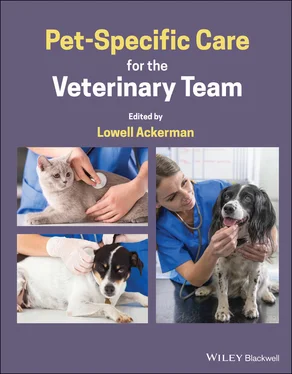With recessive traits, selection can quickly remove homozygous affected animals from breeding, but if heterozygotes cannot be detected, carriers will persist in the population. The final elimination of the trait from a breed requires identifying carriers and ensuring that no carriers are bred to one another. Even though doing so does not eliminate the deleterious allele from the population, it does ensure that no affected animals are produced.
 TAKE‐AWAYS
TAKE‐AWAYS
Genes don't cause diseases, but they may code for defective proteins that are associated with disease states.
For any particular genotype, each parent contributes one allelic variant for that trait.
Mutations can be responsible for changes along the length of a gene sequence that can have major or minor impact on the expression of that gene, depending on the mutation.
Diseases with the same name are not necessarily caused by the same genetic mutation in all breeds.
Genetic markers can prove useful in helping to identify disease risk, even when the specific disease gene has not yet been identified.
 MISCELLANEOUS
MISCELLANEOUS
Abbreviations
DNADeoxyribonucleic acid ORFOpen reading frame RNARibonucleic acid
1 Ackerman, L. (2011). The Genetic Connection. Lakewood, CO: AAHA Press.
2 Ackerman, L. (2020). Proactive Pet Parenting: Anticipating pet health problems before they happen. Problem Free Publishing.
3 Wang, W. and Kirkness, E.F. (2005). Short interspersed elements (SINEs) are a major source of canine genomic diversity. Genome Res. 15: 1798–1808.
Lowell Ackerman, DVM, DACVD, MBA, MPA, CVA, MRCVS
Global Consultant, Author, and Lecturer, MA, USA
 BASICS
BASICS
3.2.1 Summary
To understand genetics, we try to make it as simple as possible. We like to believe that traits have to be dominant or recessive and appear either on the sex chromosomes or the autosomes. We enjoy nice, clean statistics such as “approximately 25% of offspring will be affected.” In reality, the deeper one delves into genetics and statistics, the more one realizes that, for most conditions, hard statistics do not apply unless a direct test for the genotype exists, and the condition is fully penetrant and expressed. Although people want black or white, without being able to actually determine genotype, genetics is more like shades of gray.
Allele:A variant or alternative form of a gene, found at the same location on a chromosome, and which can result in different observable traits.
Dominant:Heritable characteristics, traits or diseases that are expressed when inherited even from one parent.
Genetics:The study of genes and how traits or conditions are passed from one generation to the next
Genome:The complete set of genes for an animal.
Genomics:The study of the entire genome, and its combined influence on complex diseases and the impact of environmental factors such as diet, exercise, medications, and toxins on genes.
Genotype: An individual's genetic constitution.
Heterozygote:An individual with two different alleles for a given gene.
Homozygote:An individual with two identical alleles for a given gene.
Locus:A fixed position on a chromosome for a gene or marker.
Phene:A trait or characteristic that is genetically determined.
Phenotype:Observable characteristics or traits that result from the interaction of genotype with the environment.
Recessive:Heritable characteristics, traits or diseases that are expressed only when inherited from both parents.
 MAIN CONCEPTS
MAIN CONCEPTS
When an animal inherits the same version of an allele from both parents (e.g., TT or tt), we say it is homozygous for that trait. When the alleles in a gene pair differ, we say the animal is heterozygous for that trait (e.g., Tt). For an X‐linked trait, affected males are hemizygous for the trait because they have only one X chromosome, which they get from their mother (they got the Y chromosome from their father). Whatever the combination, the pairing of actual genes is what constitutes the genotype.
On the basis of this pairing of genes, we have rules to determine the impact of genetic combinations on progeny. These rules are most applicable when a single gene pair determines how the trait will be expressed, which is known as monogenic inheritance . Progressive retinal atrophy (PRA) in Irish setters is an example of this. Other traits, such as hip dysplasia, are caused by the product of multiple gene effects, which is known as polygenic inheritance , sometimes also referred to as quantitative or multifactorial inheritance .
In a monogenic trait involving one pair of genes for locus A, four genotypic outcomes are possible (AA, Aa, aA, aa), but only three phenotypic expressions (AA, Aa, aa), because of how the alleles from mother and father combine in offspring. When two gene pairs are involved, 16 genotypic combinations are possible and, assuming all genotypes are expressed equally, nine possible phenotypes. For every n gene pairs involved in a trait, there are 4 npossible genotypic outcomes and 3 npossible phenotypic expressions.
When you realize that most traits are controlled by many gene pairs, you start to appreciate just how complicated predicting genetic outcome can be. In addition, modifiers, incomplete penetrance, epigenetics, and variable expressivity may have a significant effect on phenotypic outcome (see 3.3The Genetics of Disease).
Because accurately predicting genotypes with polygenic traits is difficult and because the environment can have a profound influence, genetic involvement in a trait is typically expressed as heritability ( h 2), which is a mathematical representation of the variance in breeding values divided by phenotypic variance. A trait's heritability can vary from 0 (no heritable component) to 1 (complete inheritance).
Dogs have 78 chromosomes (39 pairs) and cats have 38 chromosomes (19 pairs), two of which are sex chromosomes. Females are XX and males are XY. The rest of the chromosomes, which have nothing to do with sex determination, are called autosomes . Some traits, such as hemophilia, are transmitted on the X chromosome, but to date few if any disease traits seem to be transmitted on the Y chromosome of dogs and cats. Accordingly, a trait can be sex linked (actually almost always X linked, because few Y‐linked traits have been documented) if it resides on the X chromosomes, or autosomal if it resides on one of the other chromosomes. Sex‐linked traits and sex‐limited traits have to be differentiated. An example of a sex‐limited trait is cryptorchidism, the presence of undescended testicles, in that it can be seen only in males. This fact does not imply that a female cannot carry the gene for cryptorchidism or that it is sex linked and carried on the Y chromosome, which we know is not the case.
Читать дальше

 TAKE‐AWAYS
TAKE‐AWAYS MISCELLANEOUS
MISCELLANEOUS BASICS
BASICS MAIN CONCEPTS
MAIN CONCEPTS










